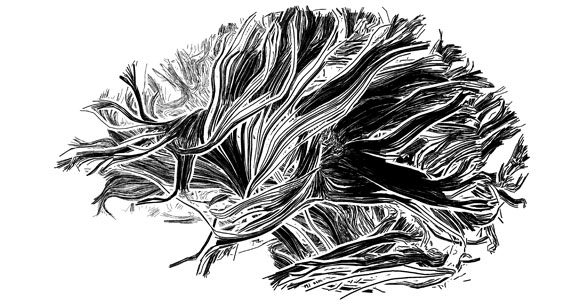
Profile: The beauty of tensor images
Professor Jos Roerdink, of the Johann Bernoulli Institute for Mathematics and Computer Science of the University of Groningen, presents new techniques for the processing and visualisation of tensor fields. Potentially, this could lead to new tools for the analysis of brain connectivity.
Mathematical morphology for tensor images
Professor Jos Roerdink, of the Johann Bernoulli Institute for Mathematics and Computer Science of the University of Groningen, presents new techniques for the processing and visualisation of tensor fields. Potentially, this could lead to new tools for the analysis of brain connectivity.
The processing, analysis and visualisation of tensor images has become very important in many application domains, such as brain imaging and seismology. In the project COMOTI – Connected Morphological Operators for Tensor Images, funded by the Dutch National Science Foundation (NWO), we address the development of techniques for morphological filtering and visualisation of tensor fields.
Prime motivation
A prime motivation for our work is brain imaging, where diffusion tensor magnetic resonance imaging (DTI) enables the it in vivo exploration of nerve fibre bundles. This allows the determination and visualisation of anatomical connections between brain regions. Whereas the theoretical and algorithmic foundations for morphological operators on scalar images are well developed, this is not the case for tensor images. Our goals are the development of new mathematical methods and efficient algorithms for analysing and understanding tensor data, and evaluating these methods in selected application domains.
The work is founded on the complete lattice framework of mathematical morphology. In this methodology, shapes of objects in binary (black and white) images are detected by moving small test shapes – structuring elements – of various forms and sizes over the image and recording the pixel locations where certain logical relations between the image and the structuring element are satisfied. In this way, it is possible to define a wealth of morphological operations that can extract various shapes and patterns from the image. Morphological image filters are nonlinear, which makes their mathematical analysis more complex.
This approach can be extended to grey scale images. A unified framework is provided by complete lattice theory, where the existence of a partial order on the space of images is essential. For the binary case this partial order is given by set inclusion, while in the grey scale case the (complete) order on the image values can be extended to a partial order on the image functions themselves. Also, it is very important to pay attention to invariance properties of the resulting operators, such as translation, rotation, or scale invariance.
Filters and connectivity
Extending morphological filters to tensor data is difficult, since there is no obvious way to define a partial order on tensors. We started with the simpler case of colour images, and are now extending the results to tensor images. By using the frame (overcomplete basis) concept it is possible to construct operators that are invariant to a given group of transformations. For example, we obtained saturation and rotation-invariant frames for colour images, leading to more intuitive and better quality results.
Of particular interest is the study of connectivity, which allows us to group pixels of the same grey value into connected components. Connectivity-preserving (‘connected’, for short) filters either remove or keep each connected component, but do not change its shape. However, the human observer sometimes interprets a single connected component as multiple visual entities, or it vice versa. To deal with such cases hyperconnectivity and associated hyperconnected filters have been proposed. The axiomatisation of hyperconnected filters is of very recent date, and extending this to tensor data will allow us to explore the full potential of such filters.
The processing of tensor images is computationally very demanding. Hence we use approximation techniques that achieve a compromise between accuracy and speed, and also foresee the use of parallel processing and special hardware such as graphical processing units (GPUs).
Future aims
Although this project has a strong theoretical orientation, we also aim for testing and validating our methods in various application domains, notably neuroscience, material science and seismology.
Future work concerns the development of morphological operators for higher order tensors, which are relevant for High Angular Resolution Diffusion Imaging (HARDI), where data for a large number of gradient directions are measured in an MRI scanner.
The project started in 2010 and will run until the spring of 2015. Its research team consists of PhD student Jasper van de Gronde, Dr Michael Wilkinson, and Prof Dr Jos Roerdink (PI). In this project, we are collaborating with Dr J Angulo, Center for Mathematical Morphology (CMM), Fontainebleau, France; and with Dr R Duits, Department of Mathematics and Computer Science, Eindhoven University of Technology, the Netherlands. We aim to expand our collaborations at the European level within the Horizon 2020 programme, in particular within the framework of Future and Emerging Technologies. We are looking forward to meeting new partners and challenges in this endeavour.

Professor Jos Roerdink
Johann Bernoulli Institute for Mathematics and Computer Science
University of Groningen
+31 (0)50 363 3931




